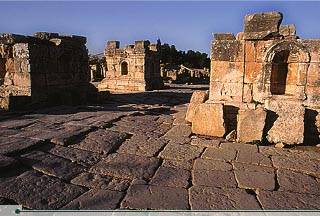 |
Keys
to the Kingdom National Anthem The Office History |
|
Pompey’s conquest of Jordan, Syria and Palestine in 63 BCE inaugurated a period of Roman control which would last four centuries. In northern Jordan, the Greek cities of Philadelphia (Amman), Gerasa (Jerash), Gadara (Umm Qais), Pella and Arbila (Irbid) joined with other cities in Palestine and southern Syria to form the Decapolis League, a fabled confederation linked by bonds of economic and cultural interest. |
 |
||
| Cross-road
at Jerash (The Southern Tetrapylon). © Michelle Woodward |
||
| Of
these, Jerash appears to have been the most
splendid. It was one of the greatest provincial cities in Rome’s empire, and was
honored by a visit of the Emperor Hadrian himself in 130 CE. In southern Jordan, the
Kingdom of Nabatea retained its independence until 106 CE, when Emperor Trajan’s
forces took control of the region. Roman road-builders followed soon after the military, and in 111 CE the Via Nova Triana (Trajan New Road) was completed. It ran from the southern port of Aqaba all the way to the Syrian city of Bosra. Forts and watch-towers were built along this and other trading routes, while Amman, Jerash, and Umm Qais were laid out with colonnaded streets and theaters. A degree of cultural tension existed between the inhabitants of Jordan, who at this time largely spoke Greek, and their Roman occupiers who decreed that Latin should be the official language of the country and that their religion should follow that of Rome. Nevertheless, it was generally a peaceful period during which a number of important infrastructural developments occurred. |